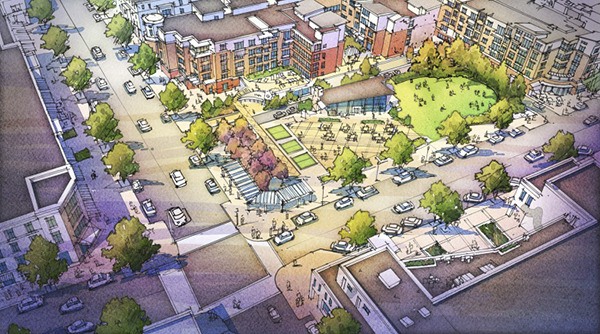“Downtown Kirkland is the heart of Kirkland, and downtown Mercer Island is wanting to be more of the heart of Mercer Island.”
Commentary from a Chamber of Commerce-assembled panel, including experts in architecture, urban planning and economic development, cut to the heart of the debate on the city’s Town Center visioning and code revision process, which has been ongoing for two years and has involved more than 40 public meetings.
Ellen Miller-Wolfe, a Mercer Island resident and economic development director of Kirkland, pointed out the disconnect that kicked off the Town Center process: what’s on the ground today in downtown Mercer Island doesn’t match the past or future vision that the community has had for the area.
The other panelists at the Feb. 4 Chamber lunch seemed to agree, including Karen True, the director of business development for the Alliance for Pioneer Square; Colin Brandt, an architect and vice-chair of the city’s Design Commission and Morgan Shook, a director at ECONorthwest under contract with the city to evaluate the economic feasibility of the proposed Town Center changes.
“It’s hard to measure heart, but it seems like people can come into a community and [feel it],” True said.
Sometimes it starts with collaboration between businesses, such as one business serving the coffee of another or a butcher providing meat to restaurants and pig ears to pet stores in the neighborhood, she said.
Shook said there’s not a lot of monetary value in creating a heart, but that Mercer Island already has value “that’s locked in the people, locked in the land, in the geography,” and that the city needs to unlock it in a way that “reinforces its values.”
“There’s an economic driver in these things, whether it’s the butcher, the baker or the candlestick maker … That hasn’t been a problem for us, whether it’s online or off-Island,” said Peter Orser, the panel moderator and former Planning Commission and City Council member. “It comes from the physical plant that we get to create: the opportunities for the retailers or the density of people that can keep those [businesses] moving, but doing that in a way where we don’t lose our heart.”
Orser was involved in Mercer Island’s “Project Renaissance” in the 1980s and 90s that resulted in its 1994 Town Center “vision.” The current Development Services Group (DSG) director for the city, Scott Greenberg, was also involved in that project, and came back to the city just as it decided to review that plan.
“We started this process in 2014 … At that time, the scope was very small,” Greenberg said.
It initially focused on how to improve the code to encourage developers to provide better plazas and other public benefits in exchange for building height bonuses.
Density and building height became a larger part of the picture as the process went on, with some residents concerned that a larger population in the Town Center would overload Island services and schools.
Following reports and recommendations from an urban planning consultant, community engagement expert and two stakeholder groups, the Town Center work is now in the third phase and being led by a joint Planning-Design Commission.
“We made a few definitive changes to the code, fixed a few things that were glaring errors … but we’re still trying to wrap our arms around all of the factors that are going to make this process work,” Brandt said.

The commission has “a bandwidth and budget” to look at a few different options for Town Center, including for building heights. One zoning map that came out of the stakeholder group, but that wasn’t unanimously supported, involved raising building heights along the highway and lowering them near Mercerdale Park. The commission recently proposed a “vastly reduced” version that would lower heights to three stories south of Southeast 27th Street.
“We’re not [proposing] that to say, ‘this is what we’re going to do,’ we’re doing it to help make sure that we listen to the public, and to the developers and the landowners and the business owners, and to get good information so we can balance the economic impacts of any of the decisions we make,” Brandt said. “The public we’ve heard from the most wants a very low Town Center … but that’s one end of the spectrum.”
Miller-Wolfe said that downtown Kirkland is “a lot of things to a lot of people.” It’s a place to gather for community events and celebrations, a place to work, shop and live and, perhaps differently from Mercer Island, a “hybrid, where it’s a downtown for visitors and tourists as much as it is a downtown for residents.”
She said that Mercer Island already has great celebrations in Town Center, from the homecoming parade to the Farmers Market. Kirkland has also experienced a recent apartment building boom downtown, but still needs visitors to “buoy the businesses.”
Brandt said that the Joint Commission is trying to find metrics to “provide the blood that pumps the heart,” like how many more people are needed to generate one more business. The answer to that question — what is the “critical mass” needed for certain retail — is unknown. Even Pioneer Square will never have the density of residents needed to get a retailer such as Whole Foods or Trader Joes, True said.
But Mercer Island has the potential to be an active daytime place if it added office space, Miller-Wolfe said, and Brandt said that’s something the commission is looking into.
Several of the audience members, including Judy King, owner of the property formerly referred to as the Hines property, and Robert Thorpe, a lawyer representing an alliance of property owners in downtown Mercer Island, said that the commission shouldn’t forget to consider the impacts on business and land owners as they move toward their final Town Center code recommendations.
The next Town Center public hearing is at 6:30 p.m. on March 9 at West Mercer Elementary.


